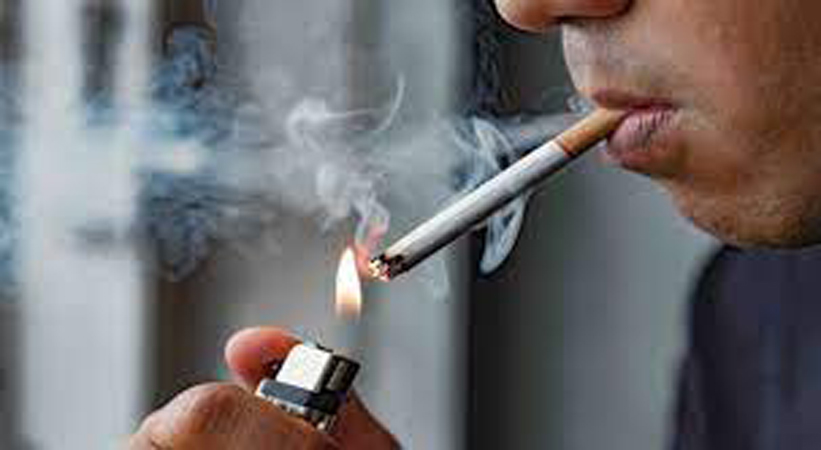9 percent of Pakistanis being wasted to smoking


With 24 million active tobacco users, Pakistan is among the world’s top tobacco-consuming countries, says a report prepared by Pakistan Institute of Development Economics (PIDE). Another Islamabad based Think Tank Capital Calling , has stated in a report that Pakistan has become a breeding ground for multinational cigarette companies.
According to an estimate, cigarette prices are the cheapest in Pakistan as compared to other countries in the region.
The think tank pressed on the need to tax cigarettes in accordance with the guidelines set by the WHO, that calls for holding cigarettes companies to account for the health and environment losses they make.
The PIDE report, however, adds that tobacco use is associated with many adverse health effects, but the tax revenue it generates cause tobacco tax policy inertia in Pakistan and other countries. “Despite evidence that higher tobacco taxation discourages tobacco consumption, Pakistan’s tax policy is among the weakest action areas in the country’s fight against tobacco,” it says.
“One explanation could be that the policymakers, who consider the tobacco industry a major contributor to government coffers, are reluctant to raise taxes fearing the revenue loss,” it says.
However, when the government abolished the third tax tier in 2019 which effectively reduced the tobacco industry’s maneuvering space to sell cheaper cigarettes by avoiding taxes, the tax contribution of the industry actually increased to 120 billion Pakistani rupees (Rs) , in just one year, compared to Rs 92 billion. This raised the tobacco industry’s share of total tax collection to 3 percent from 2.15 percent in FY16.The government’s reluctance to change tobacco tax policy is partly due to its failure to fully appreciate the smoking-attributable fraction (SAF) of health and social costs. This makes its benefit-cost analysis of tax revenue faulty and compromised over health outcomes.
The PIDE resport further states, “Smoking prevalence in Pakistan is 8.8 percent…Nationally, cardiovascular diseases are the most prevalent in the year 2019. Cardiovascular diseases are also most prevalent, followed by cancer, in urban regions, across both genders, and in Punjab and Khyber Pakhtunkhwa (KP) provinces.
The total smoking-attributable fraction of the direct cost of three diseases is Rs 100.3 billion ($0.63 billion) of which the medical cost is 96 percent (Rs 96.24 billion or US$ 0.60 billion) and non-medical cost is four percent (Rs. 4.06 billion US$0.03 billion. Smoking-attributable indirect morbidity cost is Rs 56.32 billion ($0.35 billion). The morbidity cost is 56 percent.”
Prof. Muhammad Zaman, from Quaid-i-Azam University (QAU) who teaches Sociology, said that hazards of smoking should not be calculated in segments. “The policymakers should look at it in totality. It is high time to discourage tactics of cigarette companies to influence governments the world over. We expect that the new government will not walk into the trap by these companies and will fix the loopholes in tax system to catch the big fish.”
Recent Posts
- Pakistan
Mohsin naqvi demands neutral probe into Pahalgam attack
Interior Minister Mohsin Naqvi demanded an independent investigation into the Pahalgam incident. He said Pakistan…
- World
US-Ukraine leaders meet in Rome: Productive talks on ending Ukraine-Russia conflict
US President Donald Trump and Ukrainian President Volodymyr Zelenskiy held a “very productive” meeting in…
- Pakistan
Sindh braces for heatwave until april 30
The Pakistan Meteorological Department (PMD) has warned that most parts of Sindh will face a…
- Pakistan
Imran Khan attack: Main accused sentenced to life imprisonment
In a significant development, a special anti-terrorism court (ATC) in Gujranwala has sentenced the prime…
- Sports
Abrar Ahmed credits PSL for white-ball success and growth
Mystery spinner Abrar Ahmed, representing Quetta Gladiators in HBL PSL, credits the tournament for his…
- Business
SBP governor reassures global investors on Pakistan’s economic stability
The Governor of the State Bank of Pakistan (SBP), Jameel Ahmad, reassured global investors about…
Leave a Comment